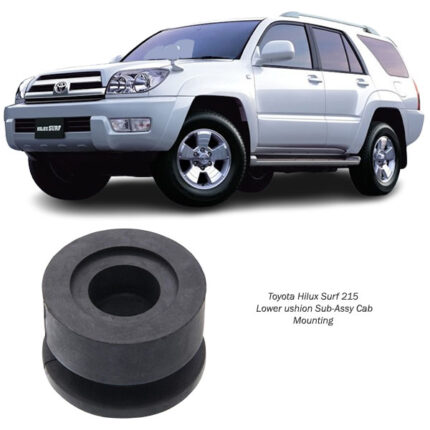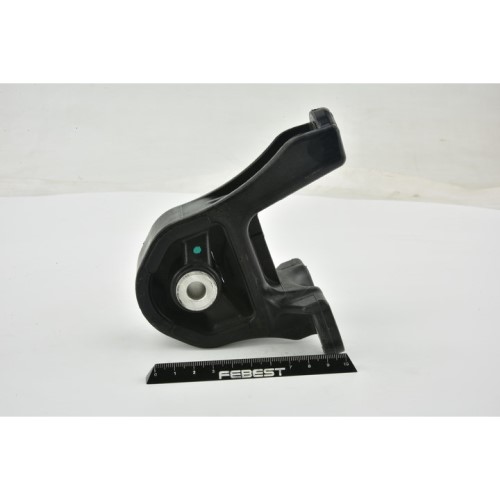-11%
Get Honda Civic CR-V Rear Differential Mount
A differential mount is a component of a vehicle’s drivetrain system, specifically designed to secure and support the differential assembly within the vehicle’s chassis. The differential mount plays a crucial role in maintaining proper alignment and stability of the differential, which is responsible for distributing power from the engine to the wheels while allowing them to rotate at different speeds.
Construction and Function:
- Material: Differential mounts are typically made of durable materials such as rubber, polyurethane, or metal alloys. Rubber and polyurethane mounts provide cushioning and dampening properties to absorb vibrations and shocks, while metal mounts offer greater rigidity and stability.
- Design: The design of a differential mount can vary depending on the vehicle’s configuration and suspension setup. Some vehicles may have multiple differential mounts to support different sections of the differential assembly.
- Mounting Points: Differential mounts are attached to specific mounting points on the vehicle’s chassis or subframe, providing a secure connection between the differential assembly and the vehicle’s structure.
Benefits;
1. Drivetrain Stability:
- Reduced Vibrations: The differential mount absorbs and dampens vibrations generated by the rotation of the driveshaft and differential gears. This helps maintain a smoother and more stable drivetrain operation, enhancing overall vehicle comfort.
2. Noise Reduction:
- Quieter Operation: By isolating the differential from the vehicle’s chassis, the mount helps minimize noise transmission from the drivetrain to the cabin. This results in a quieter and more pleasant driving experience for occupants.
3. Improved Handling and Control:
- Enhanced Stability: A well-maintained differential mount ensures proper alignment and positioning of the differential assembly. This contributes to improved vehicle stability, especially during cornering and maneuvering, by preventing excessive movement or play in the drivetrain.
4. Extended Component Lifespan:
- Reduced Wear and Tear: The differential mount helps distribute the load and stresses exerted on the differential assembly, reducing the risk of premature wear and tear on drivetrain components.
- Protection Against Impact: The mount acts as a buffer against road impacts and shocks, shielding the differential from damage caused by rough terrain or sudden jolts.
5. Enhanced Traction and Performance:
- Optimized Power Delivery: By securely anchoring the differential to the vehicle’s chassis, the mount ensures efficient power transfer from the driveshaft to the wheels. This enhances traction and performance, particularly in challenging driving conditions such as off-road terrain or slippery surfaces.
6. Maintenance of Suspension Geometry:
- Preservation of Suspension Alignment: Properly functioning differential mounts help maintain the correct suspension geometry by stabilizing the differential’s position. This ensures consistent wheel alignment and tire contact with the road surface, promoting optimal handling and tire wear.
Signs a car needs a new one;
1. Excessive Noise and Vibration:
- Increased Noise: Worn or damaged differential mounts can cause increased noise from the rear of the vehicle, especially during acceleration, deceleration, or when driving over bumps or rough roads.
- Excessive Vibration: A noticeable increase in vibrations felt in the vehicle’s cabin or through the drivetrain, particularly at certain speeds or under load, may indicate deteriorating differential mounts.
2. Loose or Unstable Rear End:
- Loose Rear End: A failing differential mount may result in increased play or movement in the rear differential assembly, leading to a loose or unstable feeling, especially during cornering or sudden maneuvers.
- Unusual Handling: Handling characteristics may become compromised, with the vehicle feeling less stable and more prone to swaying or drifting.
3. Uneven Tire Wear:
- Uneven Tire Wear: Worn differential mounts can lead to uneven weight distribution and suspension alignment, causing irregular tire wear patterns. Inspect the tires for signs of abnormal wear, such as cupping or scalloping.
4. Fluid Leaks:
- Leaking Differential Fluid: Inspect the rear differential for signs of fluid leaks, which may indicate a failing differential mount. Leaks can occur due to increased movement and stress on the differential housing caused by worn mounts.
5. Visual Inspection:
- Visible Damage or Wear: Inspect the differential mounts visually for signs of damage, such as cracking, tearing, or deterioration. Pay close attention to the condition of the rubber or polyurethane material surrounding the mounts.
- Shifted or Misaligned Mounts: Misalignment or shifting of the differential mounts may indicate wear or failure, requiring replacement to restore proper alignment and function.
6. Suspension Sag or Sagging Ride Height:
- Uneven Ride Height: A noticeable sagging or uneven ride height in the rear of the vehicle, especially on one side, may indicate a problem with the differential mounts. This occurs as the mounts lose their ability to support the weight of the rear differential assembly.
Follow us on Facebook for more parts.



